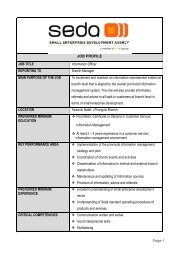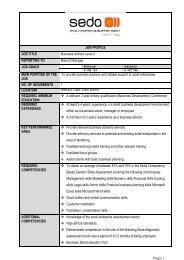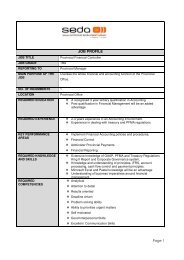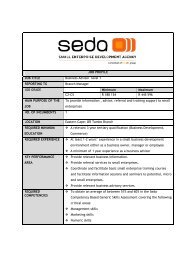Assessment of Cooperatives in the Poultry Industry - 2013.pdf - Seda
Assessment of Cooperatives in the Poultry Industry - 2013.pdf - Seda
Assessment of Cooperatives in the Poultry Industry - 2013.pdf - Seda
Create successful ePaper yourself
Turn your PDF publications into a flip-book with our unique Google optimized e-Paper software.
Research Report: Address<strong>in</strong>g <strong>the</strong> Needs, Opportunities and Challenges <strong>of</strong> <strong>Cooperatives</strong><br />
and Collectively Owned Enterprises <strong>in</strong> <strong>the</strong> <strong>Poultry</strong> and Related Industries<br />
basis. In Section 4.3 below, greater analysis is provided around <strong>the</strong> <strong>in</strong>teraction <strong>of</strong> cooperatives and<br />
small bus<strong>in</strong>esses with larger producers <strong>in</strong> both egg and broiler production.<br />
With<strong>in</strong> <strong>the</strong> cooperative structure <strong>the</strong>re are three different forms <strong>of</strong> cooperatives namely primary,<br />
secondary and tertiary. Individuals are direct members <strong>in</strong> a primary cooperative, a secondary<br />
cooperative is made up <strong>of</strong> primary cooperatives and a tertiary cooperative is made up <strong>of</strong> primary<br />
and secondary cooperatives. Different levels <strong>of</strong> cooperatives <strong>of</strong>ten perform different functions with<br />
primary cooperatives operat<strong>in</strong>g ma<strong>in</strong>ly <strong>in</strong> production while secondary cooperatives br<strong>in</strong>g toge<strong>the</strong>r<br />
o<strong>the</strong>r cooperatives and work <strong>in</strong> value added services.<br />
Only 32% <strong>of</strong><br />
cooperatives work<br />
with o<strong>the</strong>r<br />
cooperatives <strong>in</strong> <strong>the</strong><br />
area<br />
Based on <strong>the</strong> bus<strong>in</strong>ess types and <strong>the</strong> customers served by <strong>the</strong><br />
cooperatives surveyed, it is clear that <strong>the</strong>y are ma<strong>in</strong>ly primary<br />
cooperatives. There may, however, be opportunity for <strong>the</strong><br />
formation <strong>of</strong> secondary cooperatives <strong>in</strong> communities where a<br />
number <strong>of</strong> cooperatives operate. Secondary cooperatives may<br />
provide more market access and enable cooperatives to reach<br />
a greater number <strong>of</strong> customers/different types <strong>of</strong> customers.<br />
When asked whe<strong>the</strong>r <strong>the</strong>y worked with o<strong>the</strong>r cooperatives, 68% <strong>of</strong> cooperatives responded that<br />
<strong>the</strong>y did not. The benefits <strong>of</strong> work<strong>in</strong>g with o<strong>the</strong>r cooperatives <strong>in</strong>clude tra<strong>in</strong><strong>in</strong>g opportunities,<br />
knowledge shar<strong>in</strong>g, bulk buy<strong>in</strong>g, shared resources (such as transport), and <strong>the</strong> ability to supply larger<br />
quantities. Based on this it is surpris<strong>in</strong>g that a greater number <strong>of</strong> cooperatives do not partner with<br />
o<strong>the</strong>r cooperatives. Aga<strong>in</strong>, perhaps <strong>the</strong> presence <strong>of</strong> a secondary cooperative might assist primary<br />
cooperatives <strong>in</strong> comb<strong>in</strong><strong>in</strong>g <strong>the</strong>ir resources and knowledge.<br />
Approximately 17% <strong>of</strong> cooperatives reported that <strong>the</strong>ir<br />
<strong>in</strong>teractions with o<strong>the</strong>r cooperatives are limited to<br />
network<strong>in</strong>g. When asked why <strong>the</strong>y do not work with o<strong>the</strong>r<br />
cooperatives, 33% said that <strong>the</strong>y have not considered this as<br />
an option, and 50% stated that <strong>the</strong>re are ei<strong>the</strong>r no<br />
cooperatives nearby or that <strong>the</strong> o<strong>the</strong>r cooperatives <strong>in</strong> <strong>the</strong>ir<br />
area have failed and are not operational. The location <strong>of</strong><br />
many cooperatives is, <strong>the</strong>refore, a limit<strong>in</strong>g factor <strong>in</strong><br />
partner<strong>in</strong>g with o<strong>the</strong>r cooperatives.<br />
17% <strong>of</strong> cooperatives<br />
reported that <strong>the</strong>ir<br />
<strong>in</strong>teractions with<br />
o<strong>the</strong>r cooperatives is<br />
limited to<br />
network<strong>in</strong>g<br />
Figure 4-12 below illustrates some <strong>of</strong> <strong>the</strong> challenges faced <strong>in</strong> ga<strong>in</strong><strong>in</strong>g customers and secur<strong>in</strong>g<br />
contracts with larger customers. Some 26% <strong>of</strong> responses <strong>in</strong>dicated a need to improve <strong>the</strong>ir<br />
advertis<strong>in</strong>g and market<strong>in</strong>g skills <strong>in</strong> order to ga<strong>in</strong> more customers. This is partly a reflection <strong>of</strong><br />
cooperatives experienc<strong>in</strong>g a lack <strong>of</strong> customers. Some cooperatives wish to improve <strong>the</strong>ir advertis<strong>in</strong>g<br />
and market<strong>in</strong>g skills <strong>in</strong> order to become more competitive<br />
where <strong>the</strong>re are too many suppliers and not enough<br />
consumers to create demand. This is a similar concern to <strong>the</strong><br />
second item <strong>in</strong> Figure 4-12 below, namely distance from<br />
markets.<br />
Almost all cooperatives<br />
surveyed are Primary<br />
<strong>Cooperatives</strong><br />
55 | P a g e U r b a n - E c o n : D e v e l o p m e n t E c o n o m i s t s
















